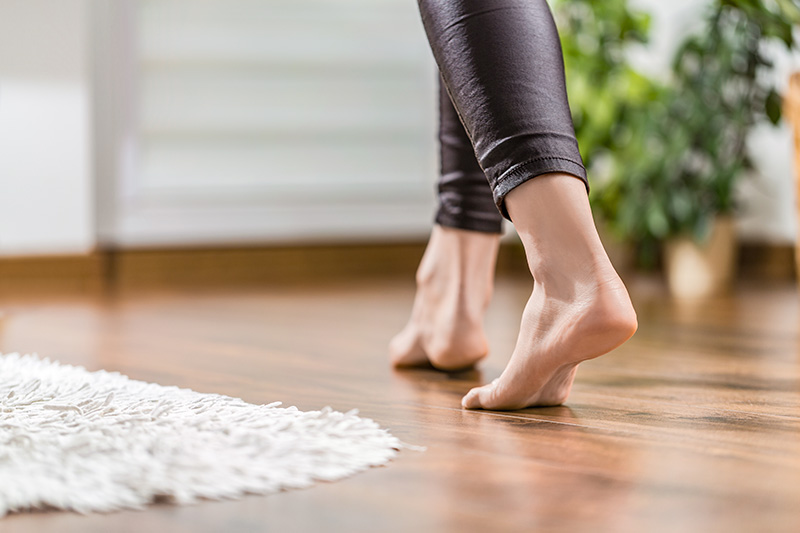The importance of slip ratings when buying flooring

Background to Slip Ratings
The National Construction Code includes safety performance requirements for safe design. Most commercial buildings are required to provide slip-resistant surfaces for safe movement, specifically in areas of emergency access and egress. The slip-resistance requirements of Clauses D2.10, D2.13 and D2.14 of the NCC state that non-slip and non-skid surfaces must be installed on pedestrian ramps, stair treads and landings. Furthermore, other parts of buildings may need to comply with disability access requirements.
What are the ratings?
There are three types of rating. We test all our products in the three types:
P = Wet Pendulum Slip Ratings
R = Oil Wet Inclining Platform
D = Dry Floor Friction
The P and R are used the most, and we aim to have an R10 and P3 on our hard flooring ranges.R was used in the past, and P is more asked for officially these days. But to put it in simple terms, people are used to R10 instead of P3. These are the same way people talk about height in 5.8” instead of 1.76m.
Why do we need slip ratings?
In the flooring industry, it is mainly to protect people walking on a floor from slipping over. The most common cause of this is water or liquids split on the floor’s surface.
What is the P test?
Wet Pendulum Slip Ratings AS 4586 Appendix A.
The test equipment consists of a swinging pendulum with a spring-loaded rubber foot. As the pendulum passes through the vertical position, the rubber foot makes contact with the wet test surface and slides across it. The resistance is recorded as a Slip Resistance Value (SRV), then classified by AS 4586. The rubber material used is often referred to as ‘Four S’, meaning ‘simulated standard shoe sole’, as this is generally accepted for assessing the slip resistance for people wearing normal and acceptable footwear. There are five classes that the SRV number can fall into. These are designated ‘P1’, ‘P2’, ‘P3’, ‘P4’ and ‘P5’. Class ‘P5’, the greatest slip resistance and P1, the least resistance.
What is the R test?
Oil Wet Inclining Platform / Ramp Slip Ratings AS 4586 Appendix D.
The oil-wet ramp slip test is performed in a similar way in which the barefoot ramp slip ratings are obtained, but in this test, oil is used instead of water and a specified safety shoe or boot is used. The most common slip rating that is specified is the R10 slip rating.The test is first conducted by a number of calibration boards walked on to ensure that the person walking on the boards is walking within the normal limits of the test, being a biological control to the slip test. With this test, the results are categorised into five classes from ‘R9’ to ‘R13’ where ‘R9’ represents a shallow angle ≥6° & ≤ 10°; ‘R10’≥10° & ≤ 19°; ‘R11’≥19° & ≤ 27°; ‘R12’≥27° & ≤ 35° and ‘R13’ the steepest angle≥35°. Note that some slippery surfaces may not meet any of these classifications.
What is the D test?
The Dry Floor Friction Test (FFT) which provides the slip ratings of surfaces that are intended for mainly internal floors that are away from potential contaminants. This test is unsuitable for assessing frictional characteristics in wet contaminated conditions. The dry test involves a battery-operated machine with a 9mm diameter Four S rubber slider. At a constant speed of 1m per minute, the opposing force on the slider is measured. The machine is sometimes referred to as a ‘dry FFT’ or the ‘Tortus’. The results of two tests are averaged, and the test result is expressed as the D rating.
How do I know which slip rating I need?
90% of the time, you will need a P3 or R10. We aim to have all our hard flooring products come with a P3 or R10 rating. As a rule, we don’t get asked for D ratings in flooring as they are not wet floor testing systems. For the full list of areas and the slip rating needed, please contact your Sales Representative or Customer Service.
What flooring products need a slip rating?
All flooring products on the floor and their finished surface need a slip rating. Yes, as a trade, we get asked for a slip rating on the carpet, and carpet manufacturers can provide it.
Does Underlay need a slip rating?
No, because it is not the finished surface you are walking on.
Where do I find our slip ratings?
All our slip ratings, P, R and D are on the spec sheets of each of our flooring products. The certificates are available on the DFO.
Does stair nosing have to have a slip rating?
Yes, they have to be R10 or P3.
Other Advice
Recommended Products
No matter what level of comfort and performance you need, Dunlop Springtred has it covered. There are 2 premium products available in the range, each offering a different level of comfort and support to suit your budget ...
Dunlop Carpetmate offers an extensive range of foam carpet underlays to help make your carpet even more comfortable. With eight different combinations of density and thickness available, you can choose the right ...